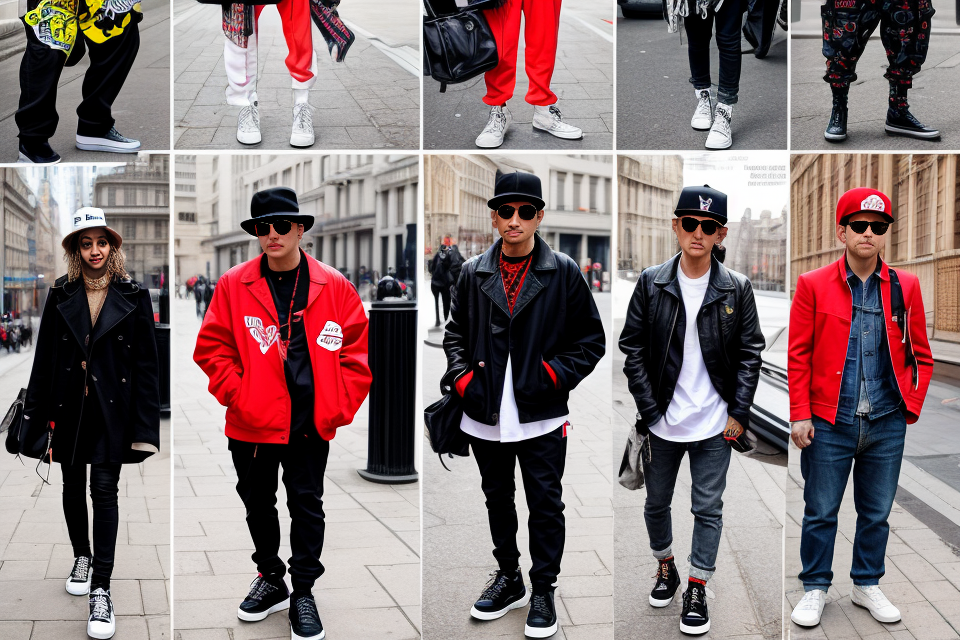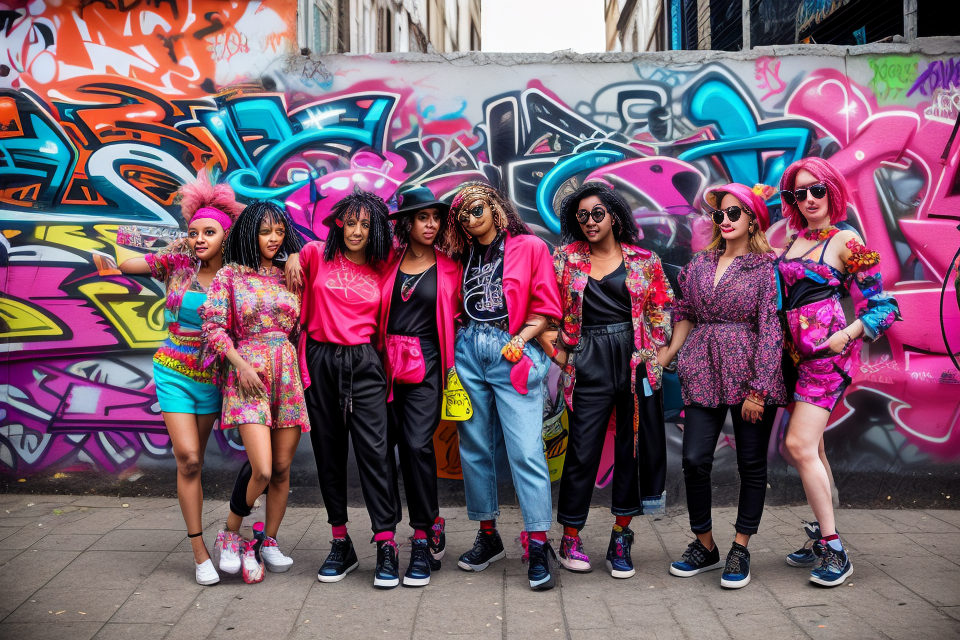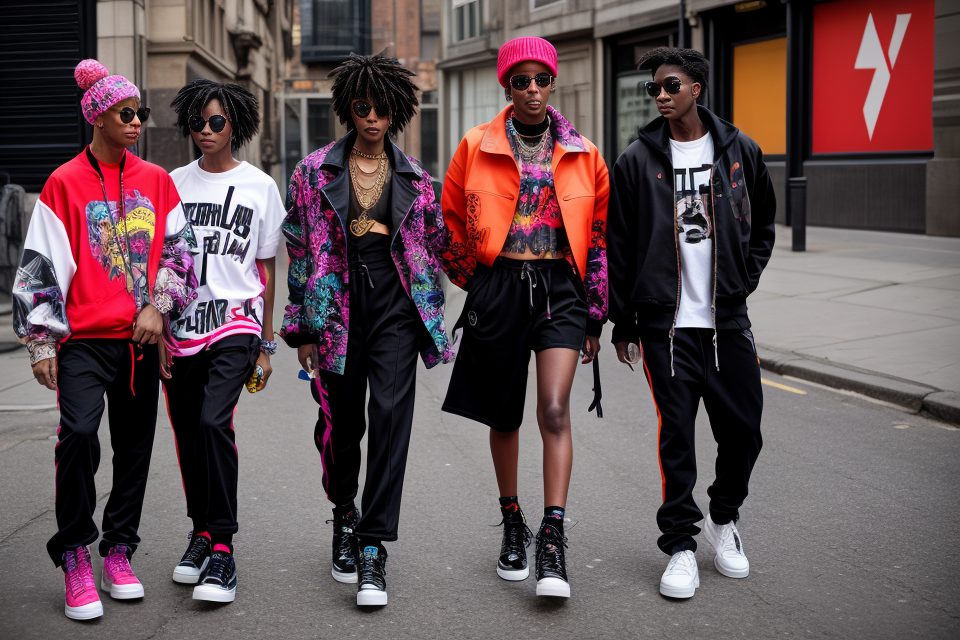
Street style has become a ubiquitous presence in modern fashion, with people around the world taking inspiration from the urban streets to create unique and bold fashion statements. But where did street style come from? How did it evolve from humble beginnings to become a global phenomenon? In this article, we’ll take a deep dive into the history and evolution of street style, exploring its origins and the factors that have contributed to its rise. From the early days of hip-hop and punk to the current global street style movement, we’ll examine the cultural and social forces that have shaped this dynamic and ever-changing fashion trend. So buckle up and get ready to explore the fascinating world of street style, where fashion and culture collide in a vibrant and captivating way.
The Roots of Street Style: Tracing Its Origins
The Evolution of Urban Fashion
Urban fashion has evolved over the years, drawing inspiration from various sources and cultures. To understand the roots of street style, it is essential to examine the evolution of urban fashion.
Early Influences on Street Style
The early influences on street style can be traced back to military and workwear. During World War II, military uniforms were a popular source of inspiration for fashion designers. Workwear, such as denim overalls and dungarees, also gained popularity in the post-war era.
Military and workwear were not the only early influences on street style. Sportswear and activewear also played a significant role in shaping urban fashion. Athletic clothing, such as tracksuits and sneakers, became popular among young people in the 1980s. This trend was fueled by the rise of sports culture and the popularity of athletes like Michael Jordan and Tiger Woods.
Pop Culture and Music
Pop culture and music have also had a significant impact on the evolution of urban fashion. The 1960s and 1970s saw the rise of the hippie movement, which popularized tie-dye, bell-bottom jeans, and fringe jackets. The punk movement of the late 1970s and early 1980s also had a significant influence on urban fashion, with punk rockers adopting a DIY approach to fashion, incorporating elements such as safety pins, ripped clothing, and spiky hair.
Hip-hop and rap culture emerged in the 1980s and 1990s, bringing with it a new set of fashion trends. Hip-hop artists such as Run-DMC and LL Cool J popularized oversized clothing, tracksuits, and baseball caps. This trend was further amplified by the success of artists like Nirvana and Pearl Jam, who embraced a more grunge-inspired aesthetic.
The Rise of Streetwear
The rise of streetwear can be attributed to several factors, including the emergence of brands and designers, the impact of hip-hop and rap culture, and the influence of skateboarding and graffiti.
The Emergence of Brands and Designers
The 1990s saw the emergence of brands and designers who helped to popularize streetwear. Brands such as Stussy, FUBU, and Supreme gained popularity among young people, and designers such as Marc Jacobs and Helmut Lang began to incorporate streetwear elements into their collections.
The Impact of Hip-Hop and Rap Culture
Hip-hop and rap culture continued to have a significant impact on streetwear in the 1990s and 2000s. Artists such as Jay-Z and Kanye West helped to popularize brands such as Ralph Lauren and Gucci, while also incorporating streetwear elements into their own style.
The Influence of Skateboarding and Graffiti
Skateboarding and graffiti culture also played a significant role in the rise of streetwear. Skateboarders such as Tony Hawk and Rodney Mullen helped to popularize brands such as Vans and Etnies, while graffiti artists such as Jean-Michel Basquiat and Keith Haring inspired a new generation of designers.
In conclusion, the evolution of urban fashion has been shaped by a wide range of influences, including military and workwear, sportswear and activewear, pop culture and music, and brands and designers. By examining these influences, we can gain a deeper understanding of the roots of street style and how it has evolved over time.
Breaking Down the Key Elements of Street Style
The Staples of Urban Fashion
Denim
The Evolution of Denim in Street Style
Denim has been a staple in urban fashion for decades, with its origins dating back to the working-class fashion of the 1800s. It wasn’t until the 1950s that denim became a popular fashion statement, thanks to Hollywood celebrities and musicians who popularized the material.
Today, denim remains a key element of street style, with various styles and washes available to suit different tastes and preferences. The evolution of denim in street style has been driven by changes in fashion trends, as well as advancements in manufacturing technology.
The Importance of Fit and Distressed Details
One of the key factors that sets denim apart from other fabrics is its versatility. The right fit can make or break an outfit, and a well-fitting pair of jeans can flatter any body type. Distressed details, such as rips and frays, add a touch of edge to an outfit and can make even the most basic denim piece feel unique.
Popular Denim Styles and Trends
From high-waisted jeans to distressed overalls, there are countless denim styles to choose from in today’s streetwear market. One of the most popular trends in recent years has been the rise of oversized denim, with brands like Boyfriend and Good American leading the way. Other popular styles include wide-leg jeans, straight-leg jeans, and bootcut jeans.
Streetwear Essentials
Hoodies and Sweatshirts
Hoodies and sweatshirts have become staples in streetwear fashion, thanks to their comfortable and casual vibe. These tops are often made from soft, breathable fabrics like cotton and polyester, making them perfect for layering under jackets or wearing alone on warmer days.
Sneakers and Athletic Footwear
Sneakers and athletic footwear have always been a key element of street style, with brands like Nike and Adidas leading the way. From classic white sneakers to bold statement pieces, there are countless options to choose from.
Backpacks and Bags
Backpacks and bags are another essential component of streetwear fashion, providing practicality and style in equal measure. From fanny packs to backpacks and tote bags, there are countless options to suit different needs and preferences.
Accessories and Statement Pieces
Accessories and statement pieces are the final touch in any streetwear outfit, adding a pop of color or a unique design element. From hats and sunglasses to statement jewelry and belts, there are countless options to choose from.
The Global Impact of Street Style
Street Style Goes International
The Influence of European Fashion
Europe has played a significant role in the evolution of street style. As urban fashion continued to gain popularity, European designers and brands began to incorporate streetwear elements into their collections. This led to a blending of high-end fashion and streetwear, creating a unique and influential style that would soon spread across the globe.
The Evolution of Streetwear in Europe
The evolution of streetwear in Europe can be traced back to the 1980s, when the sportswear trend first emerged. Brands like Adidas and Nike became popular among young people, who began to incorporate athletic wear into their everyday outfits. This trend continued to grow throughout the 1990s, with the rise of hip-hop culture and the popularity of brands like Tommy Hilfiger and Ralph Lauren.
European Brands and Designers
Many European brands and designers have contributed to the evolution of street style. Italian luxury brands like Gucci and Versace were among the first to incorporate streetwear elements into their collections, while French designers like Jean-Paul Gaultier and Thierry Mugler were known for their innovative and daring designs. British brands like Burberry and Paul Smith also played a significant role in the development of street style, with their classic and preppy aesthetic.
Street Style in Major European Cities
Major European cities like London, Paris, and Milan have long been considered fashion capitals, and they have played a significant role in the evolution of street style. London was known for its grunge and punk-inspired looks, while Paris was home to high-end fashion houses and haute couture. Milan, on the other hand, was known for its luxury sportswear brands and sleek, minimalist style.
The Influence of Asian Fashion
Asian fashion has also had a significant impact on the evolution of street style. With the rise of streetwear in Japan and South Korea, brands like Bathing Ape and Supreme became popular worldwide, and their influence can still be seen today.
The Rise of Streetwear in Asia
The rise of streetwear in Asia can be traced back to the 1990s, when Japanese brands like Bape and Undercover began to incorporate streetwear elements into their collections. This trend soon spread to South Korea, where brands like FTC and St. Alfred also gained popularity.
Asian Brands and Designers
Asian brands and designers have played a significant role in the evolution of street style. Japanese designers like Yohji Yamamoto and Rei Kawakubo were known for their avant-garde and unconventional designs, while South Korean brands like Gentle Monster and Beanpole Spole have gained popularity for their unique and trendy styles.
Street Style in Major Asian Cities
Major Asian cities like Tokyo, Seoul, and Shanghai have also had a significant impact on the evolution of street style. Tokyo is known for its unique and eclectic fashion scene, while Seoul is home to a vibrant and innovative streetwear culture. Shanghai, on the other hand, has become a hub for luxury fashion, with many international brands and designers establishing a presence in the city.
Adapting Street Style for Different Body Types and Budgets
The Importance of Personal Style
Understanding Your Body Type
One of the most important aspects of adapting street style to your personal taste is understanding your body type. Each person has a unique body shape, and it’s essential to find clothing that flatters your figure.
Tips for Dressing for Your Body Shape
Here are some tips for dressing for different body shapes:
- Apple-shaped: Emphasize your waist and shoulders with belts, jackets, and scarves. Wear A-line dresses and skirts to create the illusion of a smaller waist.
- Pear-shaped: Highlight your upper body by wearing tops and blazers that draw attention to your shoulders and chest. Avoid clingy materials that can accentuate your lower half.
- Hourglass: Embrace your curves by wearing form-fitting clothing that accentuates your waist. Add volume to your upper body with blouses and sweaters.
- Rectangle-shaped: Add curves to your outfit with belts, waistbands, and ruched fabrics. Avoid loose-fitting clothing that can make you look boxy.
The Power of Accessorizing
Accessorizing is a great way to add interest to your outfit and highlight your best features. Choose accessories that complement your outfit and add a pop of color or texture. Hats, scarves, belts, and jewelry are all great options for adding personality to your look.
Adapting Street Style on a Budget
Thrifting and Vintage Shopping
Thrifting and vintage shopping are great ways to find unique, affordable pieces that fit your personal style. Secondhand stores often have high-end brands at lower prices, and vintage pieces can be a statement-making addition to your wardrobe.
Creating Your Own Streetwear Looks
Another way to adapt street style on a budget is by creating your own streetwear looks. DIY projects can be a fun and creative way to personalize your clothing and accessories. Customizing t-shirts, adding patches to denim jackets, and upcycling old clothing are all great ways to express your personal style without breaking the bank.
The Importance of Quality Over Quantity
Finally, it’s important to remember that quality is more important than quantity when it comes to street style. Investing in a few high-quality, timeless pieces will last longer and fit better than a large number of low-quality items. When shopping on a budget, consider investing in a few key pieces that fit your personal style and can be easily mixed and matched with other items in your wardrobe.
The Future of Street Style: Trends and Predictions
The Evolution of Streetwear in the Digital Age
The Impact of Social Media on Street Style
Social media has had a profound impact on the way people perceive and engage with fashion. The rise of influencers and bloggers has given streetwear a new platform to showcase its style and aesthetic to a wider audience. Hashtags and social media campaigns have made it easier for people to discover new trends and brands, and to connect with like-minded individuals who share their passion for streetwear.
The Future of Streetwear
As streetwear continues to evolve, sustainability and ethical fashion will play an increasingly important role in its future. Consumers are becoming more conscious of the environmental and social impact of their purchases, and streetwear brands will need to adapt to meet these demands. Virtual runway shows and fashion weeks have already become a popular alternative to traditional in-person events, and the pandemic has accelerated this trend. As streetwear continues to grow and evolve, it will be interesting to see how these changes shape the future of the industry.
FAQs
1. What is street style?
1.1. Street style is a fashion style that originated in urban areas, particularly in cities like New York, London, and Tokyo. It is characterized by a mix of different fashion elements, often including oversized clothing, bold graphics, and a casual, relaxed attitude. Street style is often associated with youth culture and is influenced by various subcultures, such as hip-hop, punk, and skateboarding.
2. Where did street style come from?
2.1. The origins of street style can be traced back to the 1970s and 1980s, when youth culture began to influence fashion. During this time, cities became more diverse, and people from different backgrounds and subcultures started to mix and influence each other’s fashion choices. Street style emerged as a way for individuals to express their unique style and identity, and it quickly became popular in urban areas around the world.
3. How has street style evolved over time?
3.1. Street style has evolved significantly since its inception in the 1970s and 1980s. In the early days of street style, the focus was on practicality and functionality, with a lot of oversized clothing and sportswear influences. Over time, street style has become more refined and sophisticated, with a greater emphasis on fashion trends and designer labels. Today, street style is a highly influential force in the fashion industry, with many designers and brands drawing inspiration from the urban streets.
4. Who popularized street style?
4.1. Street style has been popularized by a variety of individuals and subcultures over the years. In the early days of street style, it was largely associated with youth culture and was popularized by young people in urban areas. As street style gained more mainstream attention, celebrities and fashion influencers began to embrace the style, further popularizing it and bringing it into the spotlight.
5. What impact has street style had on fashion?
5.1. Street style has had a significant impact on the fashion industry as a whole. It has influenced designers and brands to create more functional and practical clothing, while also pushing the boundaries of fashion with bold and innovative designs. Street style has also played a role in breaking down barriers between high fashion and streetwear, leading to the rise of collaborations and crossovers between luxury brands and streetwear labels.
6. Is street style still relevant today?
6.1. Yes, street style is still very relevant today. While it has evolved and changed over the years, it continues to be a major influence on fashion and style. Many designers and brands still draw inspiration from street style, and it remains a popular choice for individuals looking to express their unique style and identity. Additionally, the rise of social media has helped to keep street style in the spotlight, with countless influencers and fashion bloggers sharing their street style looks with a global audience.
Fall Street Fashion. Everyday Elegance Outfits Fashion Trends. Street Style.
https://www.youtube.com/watch?v=6dTG7pKSDOw


